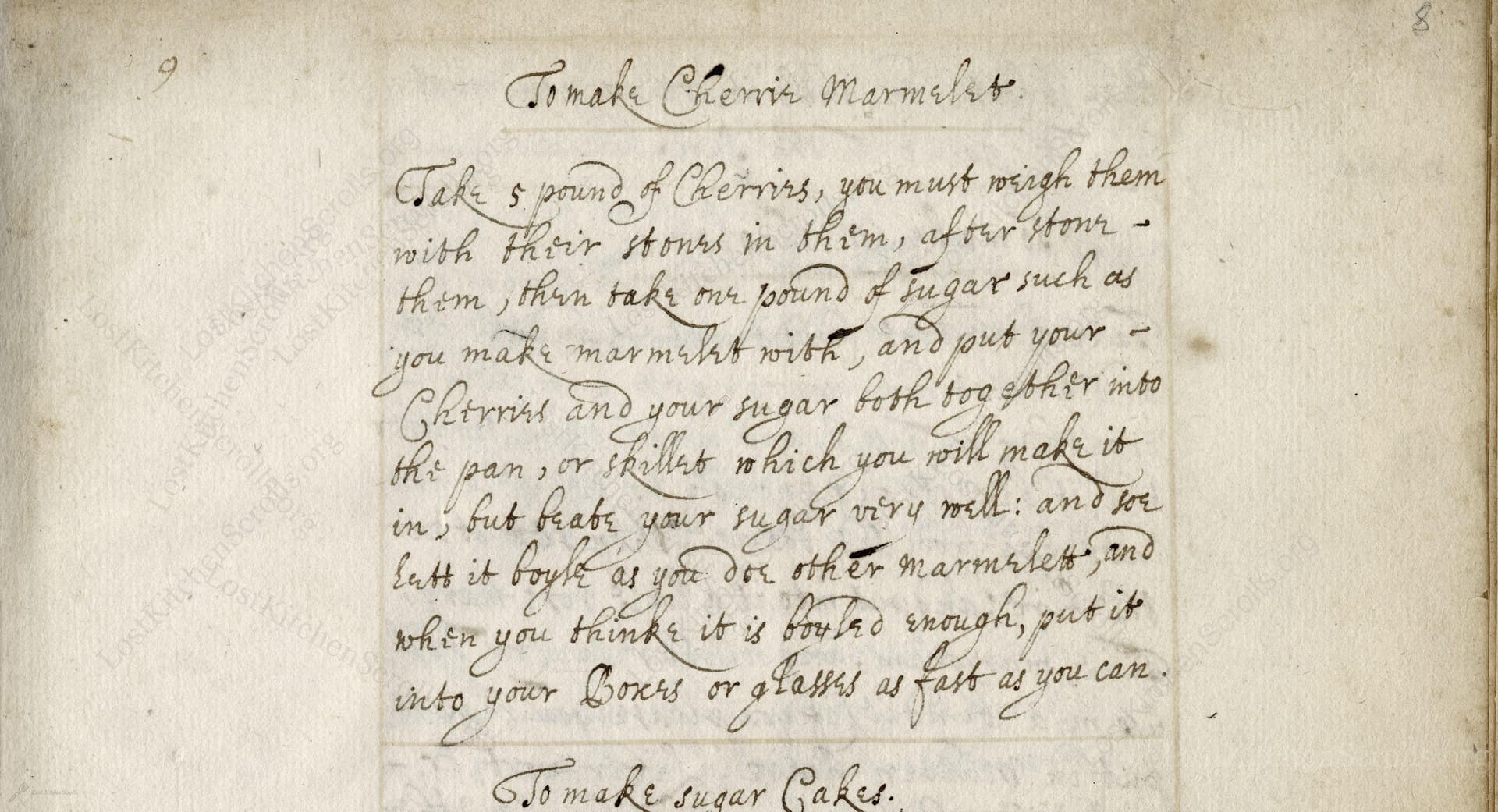
To Make Cherrir Marmalet
"Take 5 pound of Cherrirs, you must weigh them with their stones in them, after your - them, then take one pound of sugar such as you make marmalet with, and put your - Cherrirs and your sugar both tog ether into the pan, or skillet which you will make it in; but beate your sugar very well: and soe lett it boyle as you doe other marmalett, and when you thinke it is boyled enough, put it into your Boxes or glasses as fast as you can."
Note on the Original Text
This recipe is characteristic of early modern English cookery: brief, trusting the cook's experience and intuition, and using period spellings such as 'boyle' for 'boil', 'Cherrirs' for 'cherries', and 'tog ether' for 'together.' Quantities are simple and direct, and instructions omit specifics on time or temperature, reflective of pre-industrial kitchen methods. The word 'marmalet' refers broadly to fruit preserves, not just citrus as today.

Title
Receipt book of Sarah Longe (1610)
You can also click the book image above to peruse the original tome
Writer
Sarah Longe
Era
1610
Publisher
Unknown
Background
A delightful glimpse into early 17th-century kitchens, this collection by Sarah Longe whisks readers through ancestral recipes, cooking tips, and the seasonings that graced the tables of Jacobean England. Prepare to savor the tastes and traditions of times gone by.
Kindly made available by
Folger Shakespeare Library
This recipe comes to us from Sarah Longe, flourishing around 1610 in early 17th-century England—a time when preserving fruits was both a necessity and a culinary joy. Sugar was relatively expensive and precious, so recipes like this cherry marmalade were a showcase of both affluence and skill in the English household. Preserved fruit would have been enjoyed through the winter months, served at the table for both medicinal and luxurious purposes.

In the 1610s, the cook would have weighed cherries with a simple balance scale, pitted them by hand, then used a large brass or copper preserving pan over an open hearth or charcoal fire. A wooden spoon for stirring and 'boxes or glasses'—likely small wooden tubs or early glass jars—were used for storage. Sugar might be beaten in a mortar and pestle to a fine grain.
Prep Time
15 mins
Cook Time
30 mins
Servings
12
We've done our best to adapt this historical recipe for modern kitchens, but some details may still need refinement. We warmly welcome feedback from fellow cooks and culinary historians — your insights support the entire community!
Ingredients
- 5 lbs fresh cherries (measured with stones; stones then removed)
- 1 lb granulated sugar (any high-quality preserving sugar; superfine or cane sugar optional)
Instructions
- Begin with 5 lbs of cherries, weighing them whole with the stones.
- Stone the cherries and place them in a large, sturdy saucepan.
- Measure out 1 lb of granulated sugar, ideally one suitable for preserves, and beat or grind it finely.
- Add both the cherries and sugar to the pan.
- Heat gently and bring to a boil, stirring regularly.
- Continue to cook, allowing the mixture to thicken into a soft marmalade-like texture, approximately 20-30 minutes.
- Once thickened, pour the marmalade into sterilized jars or heatproof containers while still hot, and seal immediately.
Estimated Calories
110 per serving
Cooking Estimates
It takes about 15 minutes to prepare the cherries and measure the ingredients. Cooking the marmalade takes around 30 minutes. Each serving contains about 110 calories, and you can expect to get 12 servings from this recipe.
As noted above, we have made our best effort to translate and adapt this historical recipe for modern kitchens, taking into account ingredients nowadays, cooking techniques, measurements, and so on. However, historical recipes often contain assumptions that require interpretation.
We'd love for anyone to help improve these adaptations. Community contributions are highly welcome. If you have suggestions, corrections, or cooking tips based on your experience with this recipe, please share them below.
Join the Discussion
Rate This Recipe
Dietary Preference
Main Ingredients
Culinary Technique

Den Bockfisch In Einer Fleisch Suppen Zu Kochen
This recipe hails from a German manuscript cookbook compiled in 1696, a time whe...

Die Grieß Nudlen Zumachen
This recipe comes from a rather mysterious manuscript cookbook, penned anonymous...

Ein Boudain
This recipe comes from an anonymous German-language manuscript cookbook from 169...

Ein Gesaltzen Citroni
This recipe, dating from 1696, comes from an extensive anonymous German cookbook...
Browse our complete collection of time-honored recipes



